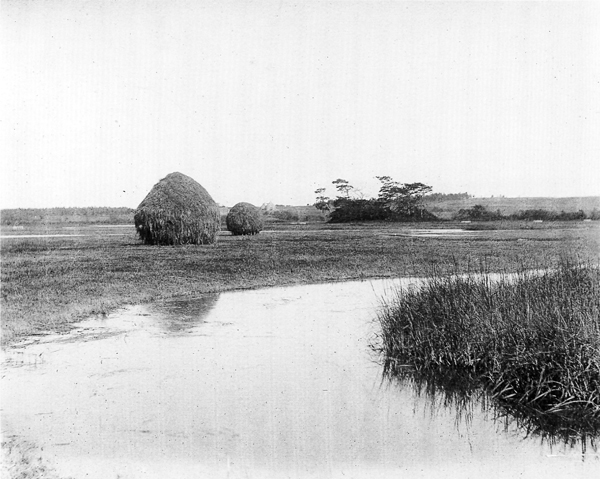B A C K T H E N
Salt Hay in the Scarborough Marshes

Scarborough, likely the turn of the century. Stacks of salt hay, perched safely above the tide on “staddles” of split cedar posts. In the 1890s the marshes were described as having hay “in numberless stacks as far as the seas.” The English being a great cattle-raising people, the natural grasslands of salt marshes and inland intervales were centers of early settlement. Cattle particularly enjoy grazing in salt marshes, biting insects notwithstanding, presum-ably because they like the taste of salt. The great importance once attached to salt marshes is indicated by the fact that Maine’s statutes regarding marsh ditching shared the same chapter with laws on fencing.
For more than two hundred years “marshing,” or haying the marshes, was an annual ritual. The dates for harvesting the lower marshes were restricted to the moon’s apogee, when tides were lowest. Men and boys, carrying their haying tools and boxes of food and jugs of drink, walked out into the marshes before first light. Mowing was all by scythes until the ‘90s, when mowing machines, drawn by calm, old horses with clumsy, noisy, wooden bog shoes clamped on their burlap-wrapped feet, were used. The mown grass was raked and “bunched,” or “cocked,” directly—marsh hay “made” almost as fast as it fell. The hay was then “poled,” or carried, to the staddles on hay poles.
The trip to the staddle could seem very long indeed. Drainage ditches tripped the unwary—the person in front was supposed to shout “Ditch!” as a warning. Custom forbade putting the load down until the staddle was reached. Stumbling along under a hot sun, hands as good as tied, with sweat stinging the eyes, giant salt marsh mosquitoes tanking up at various sensitive locations, and with greenhead flies homing in for the kill, made the punishments of Hell seem almost benign. It was said that more fat was carried onto the Scarborough marshes than was ever carried off.
The first cocks delivered to a staddle were carefully placed to form a base. The next three or four were tipped upside down in the middle, then the “stacker” climbed up and took charge. Symmetrical stack building was an art, with the rising middle kept slightly higher than the edges to shed water. Ideally the sides swelled out until tapering in for the apex. Nearing the top, the stacker exchanged his fork for a rake, drawing the hay carefully downward. Some tops were thatched and sometimes bound in place with eel grass ropes, twisted up on the spot. Two such ropes would be thrown over the stack, knots tied in the ends, and the ends shoved into holes burrowed two feet into the hay, and then tightly packed. The stacker dismounted by sliding down a rope. Hay could be left in a stack for years, but ideally it was carted or sledded off when the marshes froze. Barge-like “gondolas,” which were poled, were sometimes employed as hay carriers.
Fourteen kinds of grasses were said to grow in the salt marshes, including June grass, white top, goose grass, fox grass, branch grass, and eel grass. Blue joint made the best stock feed; “black grass” was valued as a fertilizer. Eel grass, said never to rot, was used for bedding strawberries. Coarse hay was used to pack dishes. Indians harvested fragrant sweet grass for basket making.
Beginning in the ‘70s, areas of the Scarborough marshes were diked, utilizing, in part, a bisecting railroad embankment. By employing one-way tide gates, diked land slowly desalinated, and, in time, grew high-quality upland grasses and crops. As the marshes also produced a great harvest of clams, opponents of a diking project claimed that the clams that would be lost would be worth far more than the hay that could be gained.
According to an old Scarborough resident in 1925, the abundance of fish and birds once found in the marshes could then scarcely be comprehended. Market hunters dug pools to attract ducks within range of “blow guns” which felled thirty birds with one shot. Black ducks, wood ducks, and eiders were prime targets. Picked, gutted, salted, and barreled, they were sold to hotels and restaurants.
The Down East coast also had extensive acreage of diked marshlands:
People living on the upper waters of the Pleasant River have been puzzled beyond measure for the past few days because the tide has come in and not gone out. A telephone call was made to Machias to find out if anything was the matter with the ocean but the Machias operator said the tide was working there all right. Finally several citizens started down the river and found the answer at Bryant’s Hill, a mile below Columbia Falls, where nearly an acre of dike had broken from a bluff and slid into the river damming the flow. This happened at high tide and held the flow, so that there has been no ebb since, nor will be until the river cuts a new channel through the obstruction. Old residents say there was a similar occurrence about 50 years ago. — The [Bangor] Industrial Journal, January 1913.
Text by William H. Bunting from A Days Work, Part 1, A Sampler of Historic Maine Photographs, 1860–1920, Part II. Published by Tilbury House Publishers, 12 Starr St., Thomaston, Maine. 800-582-1899.
